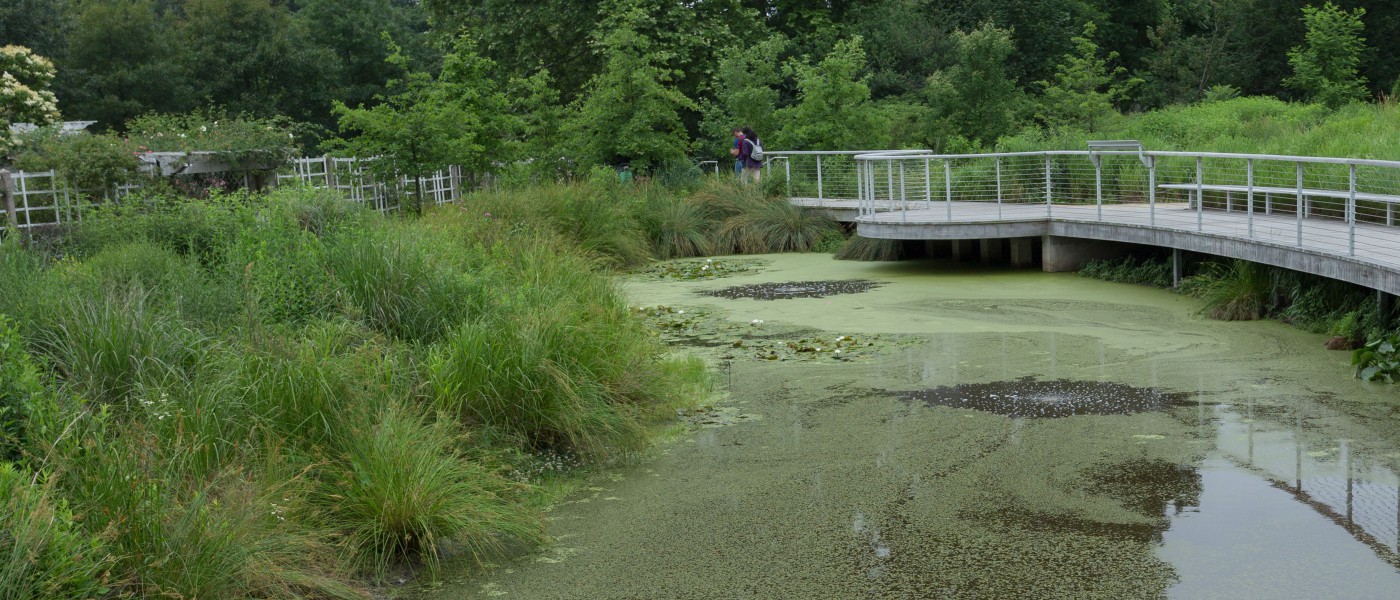Why Is the Native Flora Garden Pond Green?
“Gross! Ew! That water looks nasty!” I often hear comments like this from visitors when they first lay eyes on the pond in the Native Flora Garden. Many people assume that the green surface of the pond is due to algae, but the truth is more intriguing. The film you see on the pond now is actually made up of thousands of tiny flowering plants, including the world’s smallest one, watermeal.
The pond is now in its third year of existence, and during its first two years, prodigious growths of filamentous algae did indeed cover its entire surface during the summer. I spent a lot of time in chest waders then, hauling out as much of the algae as possible to keep it from overwhelming the young water-lilies and spatterdock.
What was the cause of these algae blooms? I suspect it was a combination of factors related to the quality of the water. The available nutrients, temperature, and pH of the water can lead to explosions of aquatic growth during warmer months. Recently filled ponds can take years to find a balance between these factors and the life they sustain.
This year, the algae have disappeared. What you see now is a motley crew of tiny flowering plants: duckweeds, pondweeds, and watermeal, the world’s smallest flowering plant.
The duckweed family (Lemnaceae) contains 38 species that float on the surface of ponds, swamps, and slow-flowing streams. They are distributed throughout the world, particularly in warm-temperate and tropical regions. These are very streamlined flowering plants, lacking leaves and stems. The family contains four genera, which are distinguished by the presence or absence of roots. In our pond we have two species from the Lemnaceae—common duckweed (Lemna minor) and watermeal (Wolffia borealis). Common duckweed can be distinguished from watermeal by its larger leaves, paler green color, and the presence of roots.
Watermeal is what’s currently covering most of the surface. Wolffia borealis is the ultimate in reduction of a flowering plant, and that earns it the title of “world’s smallest flowering plant.” Just how small is watermeal? A single plant consists of a rootless, football-shaped sphere, roughly 1 mm in length and width, about the size of the head of a pin.
Not only is watermeal Lilliputian, it reproduces at an exponential rate. Though it does flower and produce seed, it mainly reproduces asexually, or vegetatively. Watermeal produces daughter plants, which emerge from a bud embedded in a funnel-shaped pouch at the end of the plant, at a rate of two plants every three days. In other words, it can double its biomass in two days!
The other major member of the pond flora is ribbonleaf pondweed (Potamogeton epihydrus), which has relatively large leaves. Pondweed belongs to a different family (Potamogetonaceae) but is closely related to the duckweeds. The population in the Native Flora Garden's pond arrived on its own and is a good sign that the pond is becoming naturalized.
Some might say I traded one problem for another, but I see the arrival of all of these plants as a step in the right direction and part of the succession process. Watermeal, pondweed, and duckweed are all common in natural ponds. They usually arrive via the webbed feet of ducks or are carried by other birds that come to feed or drink, which is probably what happened in the Native Flora Garden too.
Still, such prolific plants needs to be controlled. How? There are fish that eat them, but they also add nutrients to the water, which ends up making the problem worse. Herbicides would work, but the potential for collateral damage to other organisms is too great a risk, and it’s not in line with BBG’s sustainability efforts.
Unfortunately for me, that just leaves frequent manual removal. The silver lining is that the duckweed and watermeal I collect go to the Garden’s compost program to be transformed into rich organic compost.
These diminutive, nutrient-rich plants can also be used directly as a soil amendment or fed to livestock, rabbits, poultry, and fish. It has been estimated that ten acres of duckweed could supply 60 percent of the nutritional needs of 100 dairy cows. Wow! Since they remove nutrients from the water so efficiently, duckweed and watermeal have also been used in wastewater treatment .
For more great info about this fascinating plant family, please visit Wayne’s Word.


